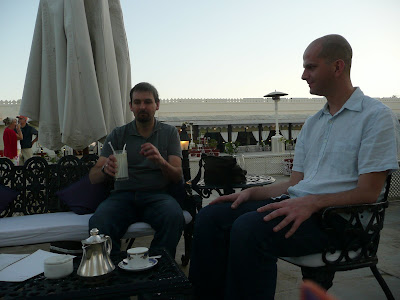

 Photos: the prayer wheels at the Buddhist temple in the centre of Mcleodganj, and views of the distant mountains taken on our walks.
Photos: the prayer wheels at the Buddhist temple in the centre of Mcleodganj, and views of the distant mountains taken on our walks.Dharamshala is our final destination on this journey. Tomorrow afternoon we are taking a small plane to Delhi to transfer to the flight home.
The part of Dharamshala where we are staying, Mcleodganj, is situated at 1750 metres above sea level (so higher than you can get in the UK). As we drove here from Amritsar we drove along flat land until we entered the state of Himachal Pradesh, after which we started climbing rapidly and going through a ribbon of villages along the road. The landscape here is made of a series of ridges, each higher than the previous. To the north of us, and visible from the road here and some of the surroundings, is a ridge at about 5000 metres, the western flanks of the Himalaya range. Our hotel room is built on a hill, so we entered from the road on the fifth floor and went down to the third floor to our room. It has a great view of the small town around us and the plains to the south, and as I write this I can see the red sky of our last sunset in India. (We won't see a sunset in Delhi – it's probably too hazy.)
Dharamshala is where the Dalai Lama resides following his exile from Tibet in 1957. As well as himself there are many Buddhist monks walking around town in their orange robes, and a good proportion of other people who, judging from their appearance, have a different ethnicity – Tibetan or perhaps from Central Asia. The book said that Tibetan people had opened restaurants for people who were tired of Indian food – following my little “incident” a few days ago I am still playing it safe and following my stomach, so one night we had pasta at a place called Oogos and the other enjoyed a great Japanese vegetarian menu tonight at another restaurant down the road, Ta Lung (Bird of the Wind). 100 rupees (£1.50) for a great plate of veggie tempura, rice, miso soup and two salads. The cheesecake afterwards was a bit – well, cheesy – it tasted disconcertingly strong and I wondered what animal it came from...
There are lots of western tourists here and other people who might be staying longer, attracted by the alternative culture here. People come here to learn massage, meditation, Tibetan, Hindi, whatever... Despite this it has a fairly relaxed feel and it is a good choice for a final destination – also with lots of shops catering for tourists, internet cafes, bookshops, tour operators, cafes...
We spent the free day taking a couple of walks in the surrounding countryside and enjoying the views, and hanging out on the main street in town. Also they have a wifi cafe (final name check for the Mandala Cafe) so it was great to sit out in the sunshine updating my blog and enjoying a banana lassi.












